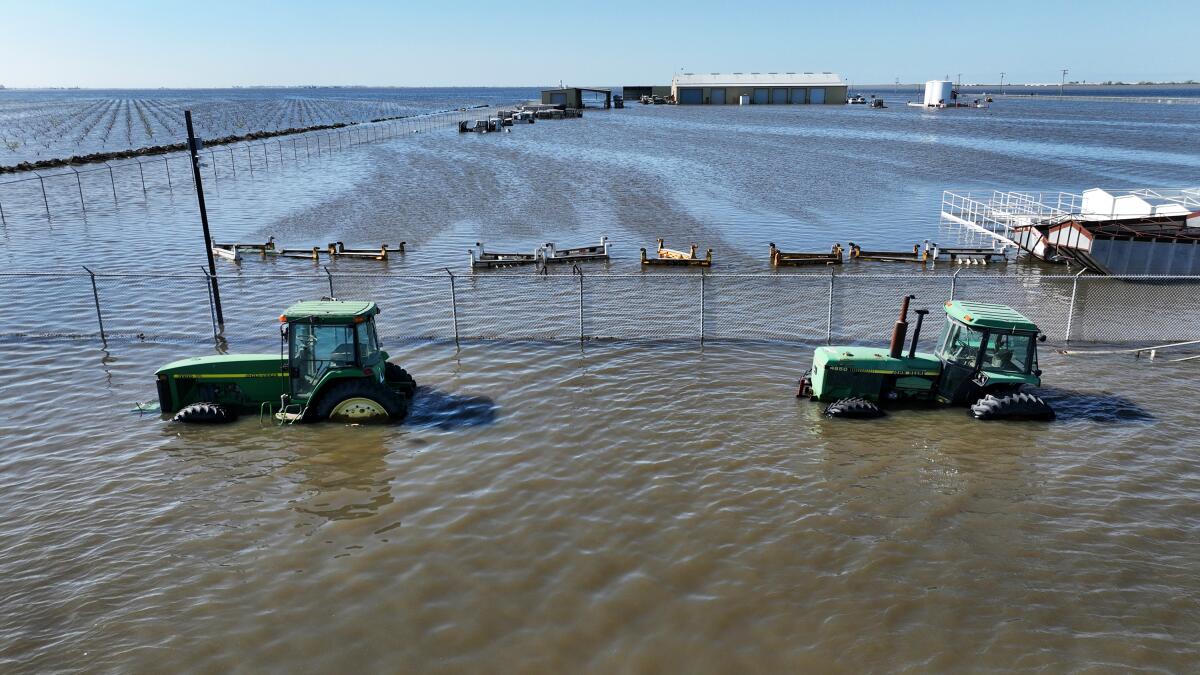Tulare Lake floodwaters now receding, Newsom’s office says. ‘We’ve turned a corner’

- Share via
After months of concern that Sierra Nevada snowmelt would send torrents of water into an already flooded Tulare Lake and inundate more communities and infrastructure, Gov. Gavin Newsom’s office has announced that the waters of the resurgent lake have finally begun to recede.
“We’ve turned a corner,” said Alex Stack, a Newsom spokesman.
In a prepared statement released Wednesday, the governor’s office said that data and inundation maps collected and prepared by state officials show that earlier estimates of potential flooding have not been met. Instead, the lake — now roughly the size of Lake Tahoe — is shrinking.
The statement credited “months of government efforts to combat flooding” and “favorable weather conditions that have slowed snowmelt,” and claimed that 66,692 acre-feet of water — or 21.7 billion gallons — have been diverted from the lakebed as a result of “early and aggressive action” by officials.
The Tachi Yokut Tribe is celebrating the return of California’s Tulare Lake, saying water should remain to heal an ecosystem that was drained for agriculture.
According to Newsom’s office, those measures included the declaration of a state of emergency, the issuing of executive orders and the implementation of preemptive water management strategies that were able to divert flows upstream from Tulare Lake and “put that water to use by recharging groundwater, replenishing storage, and more.”
Once the largest body of freshwater west of the Mississippi, Tulare Lake was drained by farmers who diverted inflows to irrigate fields of cotton, pistachios, safflower and almonds in the San Joaquin Valley.
After a series of atmospheric rivers bombarded the state this winter — piling up an epic amount of snow in the Sierra Nevada, flooding rivers and saturating the ground — water from the Kaweah, Kings and Tule rivers poured into the ancient lake’s basin, flooding fields and roads. The rising waters also threatening the the city of Corcoran and its massive prison complex, as well the communities of Stratford, Allensworth and Alpaugh.
Since the early 1900s, the lake had reformed only a few times — most memorably in 1968, 1983 and 1997.
But while state officials say the threat of the lake growing larger has abated, others say it’s not time to relax; much more needs to be done.
“We’re out of the woods for this year,” said Deirdre Des Jardins, an independent water researcher and advocate. However, “next year could be a strong El Nino year, in which case there would be an elevated risk of the kind of extreme precipitation we had in the strong El Nino year of 1982-83.”
“There needs to be a coordinated flood response plan for routing flows larger than the capacity of the canals... around the former Tulare Lake bed” she said. “Not having such a plan is a recipe for chaos.”
As historic storms fill once-dry Tulare Lake and submerge prime California farmland, tensions are building over how to handle the swiftly rising floodwaters.
She said protection for vulnerable communities and critical infrastructure “will come from emergency levee upgrades, and from making hard choices about where to route flood inflows to the Tulare Lake basin, something that the Department of Water Resources has delegated to the counties and local Reclamation Districts,” she said, describing the state’s response as a “game of hot potato.”
She also dismissed the state’s suggestion that their actions averted catastrophe: “What saved us was the cool weather, which delayed the snowmelt until the irrigation season started.”
Joe Neves, a Kings County supervisor, said he was relieved, and agreed with Des Jardins that there was still a lot of work needed to be done before the next rain season set in.
“Water flows along with longer days and higher temperatures have helped a great deal,” he said. “Seasonal irrigation demand and groundwater recharge has used a large amount of floodwater this spring.”
But lawmakers, water managers and farmers needed to begin preparing for the next rain season, he said.
He said repairs to damaged infrastructure are critical, as is expanding the floodwater management system to accommodate higher flows. In addition, he noted that river restoration projects, focused on debris removal and erosion prevention, are already underway.
“The future flood control efforts remain underway with a fresh perspective of the 2023 storm season,” he said. “Now with more focus on repairing the damaged waterways and a higher understanding of water flows in today’s environment.”











